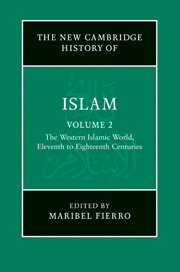Book contents
- Frontmatter
- Introduction
- PART I AL-ANDALUS AND NORTH AND WEST AFRICA (ELEVENTH TO FIFTEENTH CENTURIES)
- PART II EGYPT AND SYRIA (ELEVENTH CENTURY UNTIL THE OTTOMAN CONQUEST)
- PART III MUSLIM ANATOLIA AND THE OTTOMAN EMPIRE
- PART IV NORTH AND WEST AFRICA (SIXTEENTH TO EIGHTEENTH CENTURIES)
- PART V RULERS, SOLDIERS, PEASANTS, SCHOLARS AND TRADERS
- 19 State formation and organisation
- 20 Conversion to Islam: from the ‘age of conversions’ to the millet system
- 21 Taxation and armies
- 22 Trade
- 22A Muslim trade in the late medieval Mediterranean world
- 22B Overland trade in the western Islamic world (fifth–ninth/eleventh–fifteenth centuries)
- 22C Trade in the Ottoman lands to 1215/1800
- 23 The ʿulamāʾ
- Glossary
- Bibliography
- Index
- References
22B - Overland trade in the western Islamic world (fifth–ninth/eleventh–fifteenth centuries)
from 22 - Trade
Published online by Cambridge University Press: 28 March 2011
- Frontmatter
- Introduction
- PART I AL-ANDALUS AND NORTH AND WEST AFRICA (ELEVENTH TO FIFTEENTH CENTURIES)
- PART II EGYPT AND SYRIA (ELEVENTH CENTURY UNTIL THE OTTOMAN CONQUEST)
- PART III MUSLIM ANATOLIA AND THE OTTOMAN EMPIRE
- PART IV NORTH AND WEST AFRICA (SIXTEENTH TO EIGHTEENTH CENTURIES)
- PART V RULERS, SOLDIERS, PEASANTS, SCHOLARS AND TRADERS
- 19 State formation and organisation
- 20 Conversion to Islam: from the ‘age of conversions’ to the millet system
- 21 Taxation and armies
- 22 Trade
- 22A Muslim trade in the late medieval Mediterranean world
- 22B Overland trade in the western Islamic world (fifth–ninth/eleventh–fifteenth centuries)
- 22C Trade in the Ottoman lands to 1215/1800
- 23 The ʿulamāʾ
- Glossary
- Bibliography
- Index
- References
Summary
Introduction
Overland trade in the western half of the Islamic world was conducted through an extensive network of routes connecting cities and towns from western Asia to North Africa and across the Sahara to Central and West Africa. Long-distance trade was a complex enterprise, requiring knowledge of diverse markets and commodities and access to an extensive support system providing expertise in navigation on long routes most often across harsh terrain. It was highly lucrative not so much in terms of volume, but rather in terms of the high value of small quantities of luxury goods, transported at considerable risk. Overland trade routes of the fifth/eleventh century were based on a network of routes pioneered in the first centuries of Islam, the major achievement of which was the commercial conquest of the Sahara by Muslim merchants. The long-distance overland network often used Arabic as a common language, Islam as a common religion, and the sharīʿa as a common legal system, all in constant dynamic with indigenous traditions and languages. However, trade during this period was not simply an economic story; rather, it concerned also cultural exchange and the disposition of political power. The trading system influenced wealth, power and people in the Islamic heartland as well as outlying areas.
- Type
- Chapter
- Information
- The New Cambridge History of Islam , pp. 648 - 664Publisher: Cambridge University PressPrint publication year: 2010



